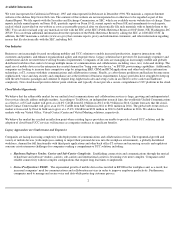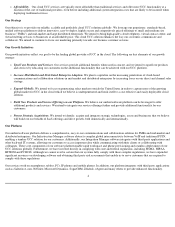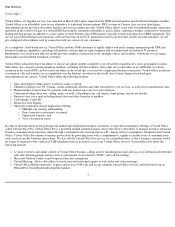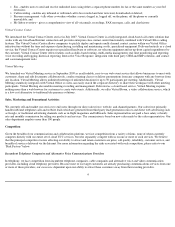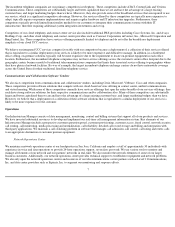8x8 2014 Annual Report Download - page 16
Download and view the complete annual report
Please find page 16 of the 2014 8x8 annual report below. You can navigate through the pages in the report by either clicking on the pages listed below, or by using the keyword search tool below to find specific information within the annual report.
target mid-market and larger distributed enterprises, our results of operations and our overall ability to grow our customer base could be
materially and adversely affected.
In addition, larger customers may demand more features, integration services and customization. We have a limited history of selling our
services to larger businesses and have experienced and may continue to experience new challenges in providing our cloud communications and
collaboration services to large customers. If a customer is not satisfied with the quality of work performed by us or a third party or with the type
of services or solutions delivered, then we might incur additional costs to address the situation, the profitability of that work might be impaired,
and the customer's dissatisfaction with our services could damage our ability to obtain additional work from that customer. In addition, negative
publicity related to our customer relationships, regardless of its accuracy, could further damage our business by affecting our ability to compete
for new business with current and prospective customers.
Intense competition in the markets in which we compete could prevent us from increasing or sustaining our revenue and increasing or
maintaining profitability.
The business of cloud communications and collaboration services is competitive, and we expect it to become increasingly competitive in the
future. We may also face competition from large Internet companies, any of which might launch its own cloud-based business communications
services or acquire other cloud-based business communications companies in the future.
In connection with our cloud telephony services, we face competition from incumbent telephone companies, cable companies and alternative
voice and video communication providers, including other providers of cloud telephony services. Because most of our target customers are
already purchasing communications services from one or more of these providers, our success is dependent upon our ability to attract these
customers away from their existing providers. The incumbent telephone companies are our primary competitors in cloud communications and
collaboration. These competitors include AT&T, CenturyLink and Verizon
Communications as well as rural incumbents, such as Windstream. In
addition, in connection with all of our collaboration and communications services, we face competition from traditional private branch exchange,
or PBX, providers, including Cisco Systems and Avaya and other providers of cloud telephony and contact center services, such as Comcast,
inContact, Microsoft and RingCentral.
Many of our current and potential competitors have longer operating histories, significantly greater resources and brand awareness, and a larger
base of customers than we have. As a result, these competitors may have greater credibility with our existing and potential customers. They also
may be able to adopt more aggressive pricing policies and devote greater resources to the development, promotion and sale of their products than
we can to ours. Our competitors may also offer bundled service arrangements that offer a more complete or better integrated product to
customers. Competition could decrease our prices, reduce our sales, lower our gross profits or decrease our market share. In addition, our
customers are not subject to long-term contractual commitments to purchase our services and can terminate our service and switch to
competitors' offerings on short notice.
Given the significant price competition in the markets for our services, we are at a significant disadvantage compared with many of our
competitors, especially those with substantially greater resources who may be better able to withstand an extended period of downward pricing
pressure. The adverse impact of a shortfall in our revenues may be magnified by our inability to adjust our expenses to compensate for such
shortfall. Announcements, or expectations, as to the introduction of new products and technologies by our competitors or us could cause
customers to defer purchases of our existing products, which also could have a material adverse effect on our business, financial condition or
operating results.
Because we recognize revenue from customer subscriptions over the term of the relevant contract, the effects of customer additions,
cancellations and changes in subscribed services are not immediately reflected in full in our operating results.
As a subscription-based business, we recognize revenue over the term of each of our contracts, which generally range from one to five years. As
a result, much of the revenue we report each quarter results from contracts entered into during previous quarters. Consequently, a shortfall in
demand for our cloud communications and collaboration services or a decline in new or renewed contracts in any one quarter may not
significantly reduce our revenue for that quarter but could negatively affect our revenue in future quarters. Accordingly, the effect of significant
downturns in new sales or cancellations of our services and subscriptions from new customers or for additional services from existing customers
will impact our ongoing monthly recurring revenue but will not be reflected fully in our operating results until future periods. Our revenue
recognition model also makes it difficult for us to rapidly increase our revenue through additional sales in any period, as revenue from new
customers must be recognized over the applicable term of the contracts.
12


